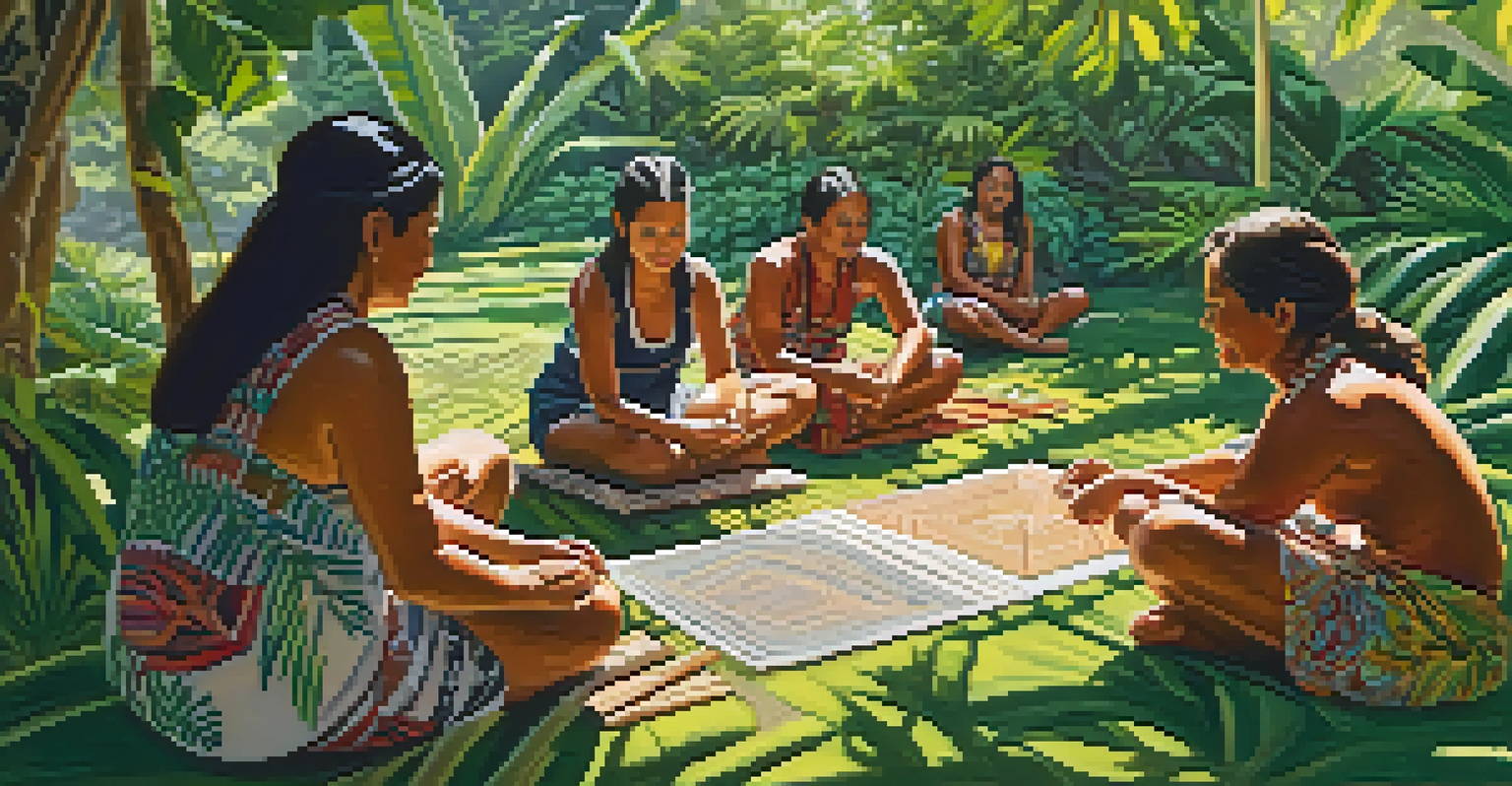Cultural Tourism in Hawaii: Trends and Economic Implications

Understanding Cultural Tourism and Its Significance
Cultural tourism involves traveling to experience the culture, heritage, and lifestyle of a destination. In Hawaii, this means immersing visitors in the unique traditions of Native Hawaiian communities, from hula performances to traditional luaus. Unlike typical beach vacations, cultural tourism invites deeper engagement, making it vital for preserving local identity.
Traveling – it leaves you speechless, then turns you into a storyteller.
This form of tourism not only enriches visitors' experiences but also fosters respect and understanding for Hawaiian culture. By participating in cultural practices, tourists gain insight into the values and history of the islands. Consequently, this creates a more meaningful connection between travelers and the local population.
Furthermore, cultural tourism can drive economic growth by attracting visitors year-round, beyond the peak seasons for sun and surf. As tourists seek authentic experiences, they contribute to the local economy, supporting artisans, cultural sites, and educational programs that celebrate Hawaiian heritage.
Current Trends in Hawaii's Cultural Tourism
Recent trends show a significant rise in demand for authentic cultural experiences in Hawaii. Travelers are increasingly looking for immersive activities, such as guided tours that highlight the islands' history and indigenous practices. This shift indicates a growing awareness of and appreciation for cultural richness among tourists.

Moreover, social media plays a pivotal role in shaping these trends. Platforms like Instagram and TikTok showcase diverse cultural experiences, encouraging others to seek similar adventures. Consequently, local businesses are adapting their offerings, ensuring they align with these interests, which further enhances the tourism landscape.
Cultural Tourism Enriches Experiences
Cultural tourism fosters a deeper connection between visitors and local communities, enhancing understanding and respect for Hawaiian heritage.
Sustainability is another trend, as many visitors are now prioritizing eco-friendly and culturally sensitive practices. This has led to the development of programs that educate tourists on responsible tourism, including respecting sacred sites and supporting local economies. Such initiatives not only protect Hawaii's resources but also promote a deeper understanding of its cultural significance.
Economic Benefits of Cultural Tourism in Hawaii
Cultural tourism brings substantial economic benefits to Hawaii, as it generates revenue for local businesses and creates jobs. From hotels and restaurants to artisans and tour guides, the ripple effect of tourism can be seen across various sectors of the economy. This diversification is crucial for the islands, particularly in times of economic downturns.
Cultural tourism is not just about visiting a place, but about understanding its people and their stories.
Additionally, cultural tourism often leads to reinvestment in local communities. Profits from tourism can fund cultural preservation projects, educational initiatives, and infrastructure improvements. This not only enhances the tourist experience but also ensures that the local culture and heritage are maintained for future generations.
Furthermore, cultural tourism fosters partnerships between local communities and the tourism industry. Collaborative efforts, such as joint marketing campaigns or community-led events, can amplify the appeal of Hawaii as a cultural destination. This synergy not only boosts the economy but also empowers residents by giving them a stake in the tourism narrative.
Impact on Native Hawaiian Communities
While cultural tourism offers economic opportunities, it also raises concerns for Native Hawaiian communities. The influx of visitors can sometimes lead to the commodification of culture, where traditions are altered to cater to tourist expectations. This can dilute the authenticity of cultural experiences and create tensions between locals and visitors.
To address these challenges, many Native Hawaiian organizations have taken proactive measures to ensure that cultural practices are represented authentically and respectfully. By providing educational resources and facilitating workshops, these organizations help tourists appreciate the depth of Hawaiian culture beyond surface-level experiences.
Economic Growth Through Authenticity
By attracting visitors year-round for unique cultural experiences, cultural tourism supports local economies and creates job opportunities.
Moreover, involving Native Hawaiians in the tourism narrative empowers communities to share their stories on their own terms. This not only preserves cultural integrity but also fosters a sense of pride and ownership among residents, contributing to a more sustainable and respectful tourism model.
Challenges Facing Cultural Tourism in Hawaii
Despite the benefits, cultural tourism in Hawaii faces numerous challenges, including overtourism, which can strain local resources. Popular cultural sites often become overcrowded, leading to environmental degradation and negatively impacting the visitor experience. Balancing the influx of tourists while preserving cultural sites is a pressing issue for stakeholders.
Moreover, the COVID-19 pandemic highlighted the vulnerability of the tourism sector, prompting a reevaluation of tourism practices. As the industry recovers, there’s a unique opportunity to implement strategies that promote sustainable cultural tourism, ensuring that the lessons learned are integrated into future planning.
Additionally, ongoing dialogue between local communities and the tourism industry is essential in addressing these challenges. By fostering collaboration, stakeholders can create a tourism model that respects local culture, supports economic growth, and protects the environment, ensuring a harmonious relationship between visitors and residents.
The Role of Education in Cultural Tourism
Education plays a crucial role in promoting cultural tourism in Hawaii. By educating both tourists and residents about the significance of Hawaiian culture, stakeholders can foster a more respectful and enriching travel experience. Workshops, cultural classes, and guided tours are effective ways to impart this knowledge to visitors.
Additionally, educational programs can empower local communities by providing them with the tools to share their culture confidently. By offering training in tourism management and cultural practices, residents can take an active role in shaping their tourism offerings, ensuring that their heritage is celebrated authentically.
Sustainability and Education Are Key
Promoting responsible tourism practices through education empowers both tourists and local communities to preserve Hawaii's culture and environment.
Furthermore, educational initiatives can also raise awareness about sustainability and responsible travel. By emphasizing the importance of protecting Hawaii’s natural and cultural resources, tourists can become advocates for preservation, contributing to a more sustainable future for the islands.
Future Prospects for Cultural Tourism in Hawaii
Looking ahead, the future of cultural tourism in Hawaii appears promising, with a growing interest in immersive experiences. As travelers become more conscious of their impact, there’s an increasing demand for tourism that respects and uplifts local cultures. This trend suggests a shift toward more responsible tourism practices in the islands.
Additionally, technological advancements can enhance the cultural tourism experience. Virtual reality, for instance, could allow potential visitors to experience Hawaiian culture before they arrive, sparking interest and encouraging them to engage more deeply once they do. Such innovations can help bridge the gap between cultures and promote understanding.

Ultimately, the successful growth of cultural tourism in Hawaii will depend on collaboration among stakeholders, including local communities, government, and tourism operators. By working together, they can create a sustainable tourism model that benefits both visitors and residents, ensuring that Hawaii’s rich cultural heritage is preserved for generations to come.